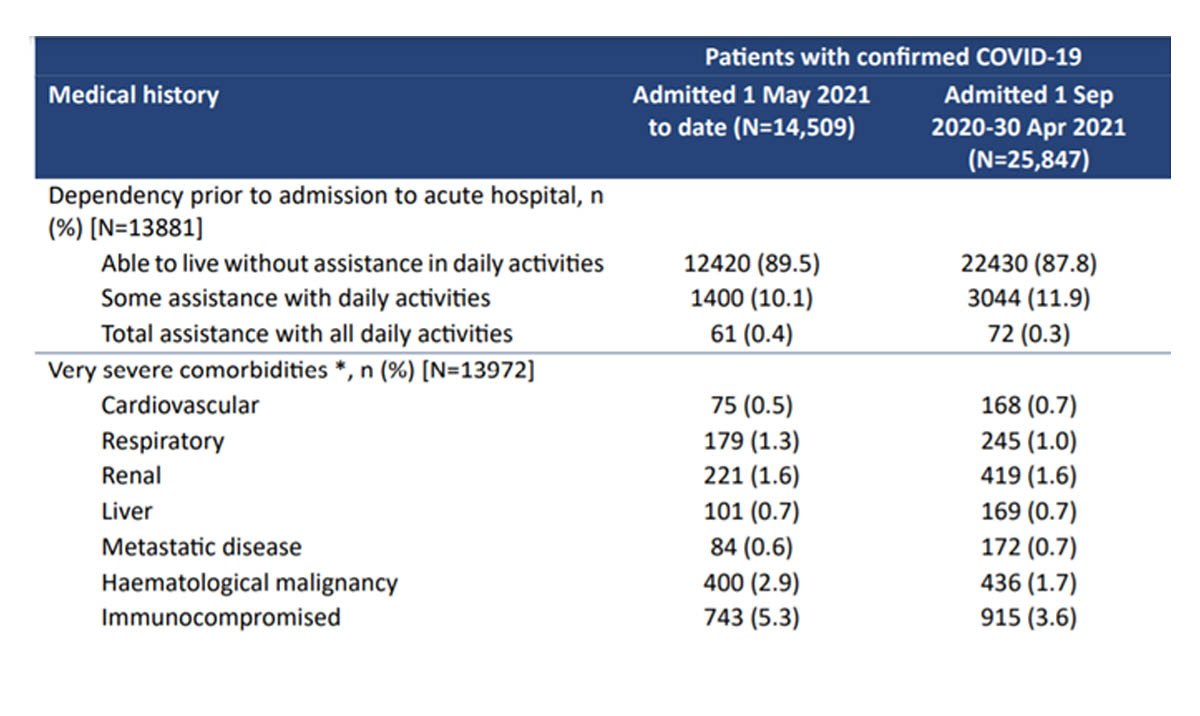
In my very first West Country Voices article I debunked the claim that “There have only been 388 Covid-19 deaths among the under-60s in the UK,” reported in various newspapers back in December 2020.
Last week, a similar claim started doing the rounds. People were tweeting figures such as “only 17,000 people have died of Covid-19 in the UK” or “only 10 per cent of supposed Covid-19 deaths were actually Covid-19 deaths.”
Neither of those claims rang true. The Office for National Statistics (ONS) publishes the number of deaths ‘involving’ Covid-19 (Covid-19 mentioned anywhere on the death certificate) and the number of deaths ‘caused by’ Covid-19 (Covid-19 directly involved in the death). Throughout the pandemic, deaths caused by Covid-19 were between 80-90 per cent of the total deaths where Covid-19 was involved.
ONS figures, up to the end of December 2021, showed that 139,839 people in England and Wales had died with Covid-19 as the underlying cause.
Where had the 17,000 figure come from?
On 16 December 2021 the ONS responded to a Freedom of Information request asking “Please can you advise on deaths purely from Covid-19 with no other underlying causes.”

The figures they gave added up to 17,371.
So, does that mean that the other 122,462 Covid-19 deaths reported by the ONS were actually caused by something else?
No, absolutely not. Although, sadly, many of the high-profile figures who have made their careers off the back of minimising Covid-19, certainly set about spreading that idea. The ONS response contained a link to the actual data they used to respond to the request. Let’s have a look at the definitions they use.
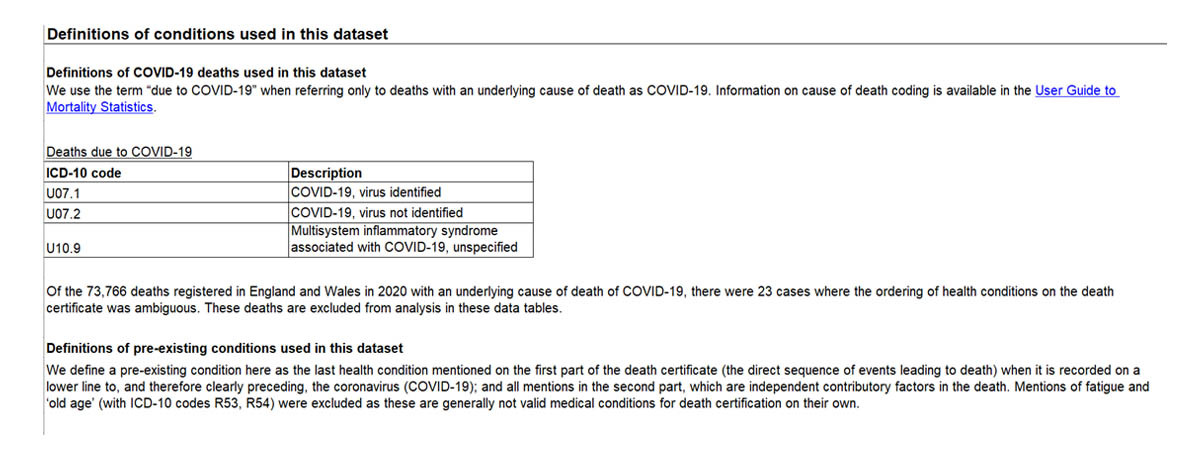
The ONS uses the term ‘due to Covid-19’ when referring only to deaths with an underlying cause of death as Covid-19. This excludes any deaths where a patient tested positive for Covid-19, but Covid-19 played no part in their death – such as a car crash victim. You can see from the screenshot that they state: “Of the 73,766 deaths registered in England and Wales in 2020 with an underlying cause of death of COVID-19 …” That does not tally with the idea that only 17,000 people died of Covid-19.
What goes on a Death Certificate?
It’s worth briefly clarifying how death certificates are completed, as explained to me by a doctor on twitter.
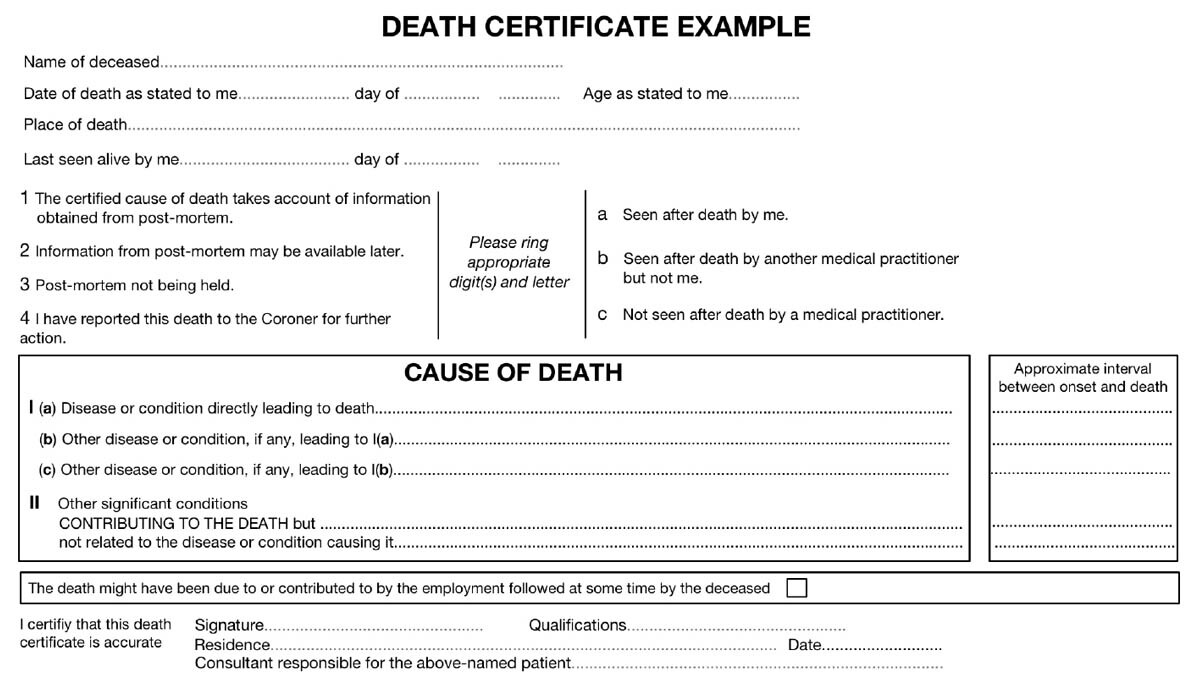
Under ‘Cause of Death’ there are two sections: Parts I and II.
Part I is for the disease or condition(s) that led directly to death. There is often a sequence of events so it might read:
1(a) Acute Respiratory Distress Syndrome (ARDS)
1(b) Pneumonia
1(c) Covid-19.
This would mean that a Covid-19 infection led to pneumonia, which caused ARDS, which is what ultimately killed the patient.
Part II is for any other health factors such as diabetes, obesity, high blood pressure, etc.
The doctor said they tended to record all known health issues in Part II as it helps with research into which underlying health conditions are risk factors for Covid-19. If a patient dies from being in a car crash, but they are also infected with Covid-19, then Covid-19 will be mentioned in Part II but not Part I.
The ONS only counts deaths as being caused by Covid-19 if it is mentioned in Part I.
It is worth noting that it is unusual to find death certificates with only one health issue mentioned. Death usually follows a sequence of events, all of which will be noted. Here are some of the underlying conditions mentioned in Part I and Part II of death certificates for patients who died of Ischaemic Heart disease in 2019:
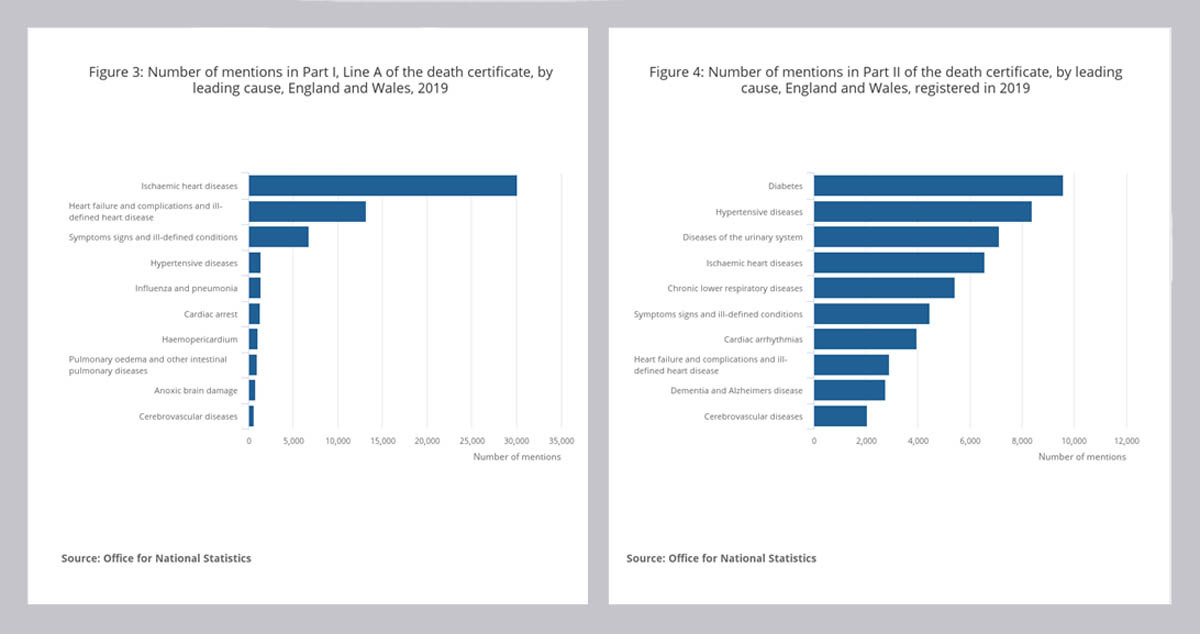
I’m not sure anyone would try and argue that they didn’t really die of ischaemic heart disease just because there were other factors mentioned on the death certificates.
Underlying Health Conditions
OK, so now we know how deaths are certified and what sort of factors are recorded on a death certificate, let’s look at some of the underlying health conditions found in Covid-19 patients.
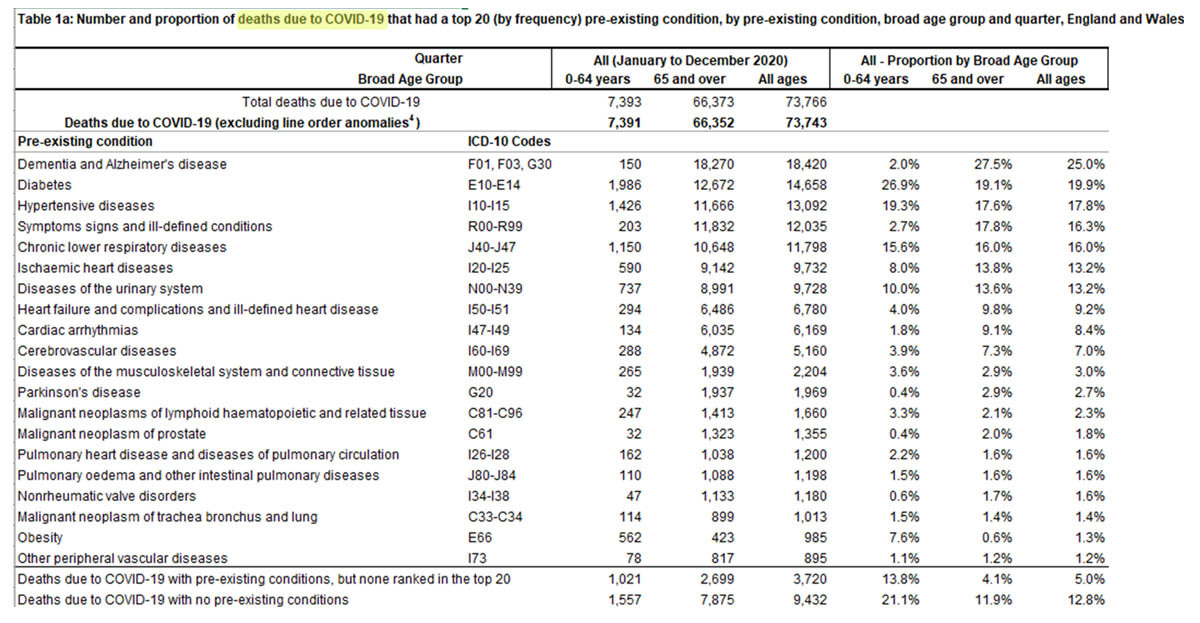
Just to reiterate: these are all deaths where a doctor considered Covid-19 to be the cause of death. Taking just a few of them, one at a time, let’s see what they mean and how common they might be.
Dementia and Alzheimer’s
Around 850,000 people in the UK have some form of dementia. This includes 1 in 14 over 65s and 1 in 6 over 80s. Dementia and Alzheimer’s (taken together) was the leading cause of death in 2018 and 2019, with 69,000 and 66,000 registered deaths respectively. In 2020, dementia and Alzheimer’s was the second leading cause of death, after Covid-19, with 70,000 registered. This shows that people were still dying from dementia and being recorded as such in 2020. This suggests that the people who died from Covid-19 while suffering from dementia were people living successfully with their diagnosis up to that point.
Diabetes

Around 5m people in the UK have a diagnosis of diabetes. The vast majority are living full, busy, normal lives alongside their condition. Sir Steve Redgrave won five Olympic Gold medals as a diabetic. To suggest that if a diabetic successfully managing their condition catches Covid-19 and dies, their death should be attributed to the diabetes and not to Covid-19 is absurd.
Hypertensive Diseases
This refers to hypertension or high blood pressure. It is thought that 14.5m people in the UK suffer from hypertension, with around four million being undiagnosed. This means around one in four adults are living with a condition that is a contributory factor in deaths from heart attack, strokes, heart failure and kidney disease.
Symptoms, signs and ill-defined conditions
This category covers all manner of things from gangrene to hiccoughs, loss of taste/smell (a classic Covid-19 symptom) to hoarseness, strange and inexplicable behaviour through to nervousness. It is a category that accounts for 16 per cent of all the underlying conditions mentioned on Covid-19 death certificates.
I imagine it can be deemed with some degree of confidence, that none of those conditions were the real cause of death in a Covid-19 patient.
Chronic lower respiratory disease
This covers chronic obstructive pulmonary disease (COPD), emphysema, and asthma. Around one in five people (12.7m) fall into this category, the vast majority of whom are living full and productive lives despite their condition.
So, those were the top five underlying health conditions found on the death certificates of Covid-19 patients. Some of the others, in brief, include cardiac arrhythmia (mostly harmless, found in 2m people), diseases of the musculoskeletal system and connective tissue (carpal tunnel, rheumatoid arthritis, tendonitis, lupus, ligament sprains …), diseases of the urinary system (kidney stones, cystitis, enlarged prostate and incontinence), and many more, non-life-threatening disorders. In the 2021 data fractured femurs (thigh bone) came up in the top 20.
Were patients about to die anyway?
Given that we know that Covid-19 disproportionately affects the elderly, it’s reasonable to wonder whether most patients were close to the end of their natural life and were so frail that they would have died shortly anyway. We have several sources of information that combine to show that is not the case in general, although of course it will have been the case for some.
Firstly, a study in the Lancet looking at frailty and Covid-19 deaths showed, not surprisingly, that the more frail you were, the worse your outcomes would be if you got Covid-19. However, the study found that, even in the most fit category, seven per cent of the patients in hospital being treated for Covid-19 did not survive. By contrast, 55 per cent of the most frail – those considered terminally ill – survived their Covid-19 infection.
Secondly, The Intensive Care National Audit and Research Centre publish a quarterly report into the patients they treat. Here is a table from the most recent report:
You can see that around 90 per cent of the patients being treated in intensive care for Covid-19 were living normal, unassisted lives prior to their infection. It is also interesting to note that fewer than 15 per cent of the patients had what is considered to be a severe comorbidity. The vast majority of these patients were living full lives and were not severely ill prior to catching Covid-19.
A third important measure is a calculation of the Years of Life Lost (YLL) when looking at all the deaths caused by a disease in a population. Various different studies: Nature Briefing, Wellcome Open Research and The Health Foundation, give a range between 10 and 14 years of life lost for each Covid-19 death in the UK. This is six times higher than for seasonal flu and eight times the years lost to transport accidents.
The final piece of evidence is ‘excess deaths’. Every year in the UK around 600,000 people die, and it is possible to look at how many more deaths occurred during the pandemic period than would normally have been expected. The ONS have calculated 127,704 excess deaths in England and Wales, from the start of the pandemic up to 7 January 2022.
These all combine to show very clearly that, while for some of the most frail Covid-19 may have hastened their death, on average, Covid-19 deaths took more than ten years of life from people, and nearly 130,000 more people died in 2020 and 2021 than would have been expected had the pandemic not happened.
Conclusions
I really hope that this has cleared up any confusion regarding whether or not people really died of Covid-19, and whether a Covid-19 death in someone with an underlying condition should be classed as a Covid-19 death or not. Have a think about what sort of underlying conditions you or your loved ones may be affected by. In a twitter poll I asked how many of these conditions people had themselves, and found 70 per cent of respondents had at least one, while 15 per cent had three or more!
I have only covered the data and facts on this area. I haven’t touched on the messaging and morality behind the concept of categorising those that died into those who are in ‘perfect’ health and those who may be ‘slightly less than perfect’. I’ll leave that for someone else to discuss. If you see a figure in the media of around 3,000 Covid-19 deaths, then that is where they have excluded anyone aged over 80 (half of whom had no underlying conditions) and anyone with a mental health diagnosis or autism.
I can’t even begin to comment on that claim.
You can listen to Emma speaking to Tim Harford on this subject on Radio 4’s More or Less here.

